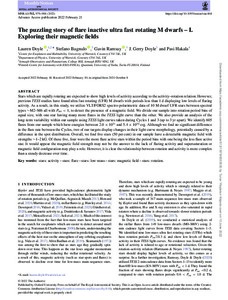The puzzling story of flare inactive ultra fast rotating m dwarfs. I. exploring their magnetic fields
Doyle Lauren; Bagnulo Stefano; Ramsay Gavin; Doyle J. Gerry; Hakala Pasi
The puzzling story of flare inactive ultra fast rotating m dwarfs. I. exploring their magnetic fields
Doyle Lauren
Bagnulo Stefano
Ramsay Gavin
Doyle J. Gerry
Hakala Pasi
OXFORD UNIV PRESS
Julkaisun pysyvä osoite on:
https://urn.fi/URN:NBN:fi-fe2022081154372
https://urn.fi/URN:NBN:fi-fe2022081154372
Tiivistelmä
Stars which are rapidly rotating are expected to show high levels of activity according to the activity-rotation relation. However, previous TESS studies have found Ultra Fast Rotating (UFR) M dwarfs with periods less than one day displaying low levels of flaring activity. As a result, in this study, we utilize VLT/FORS2 spectropolarimetric data of ten M dwarf UFR stars between spectral types similar to M2 - M6 all with P-rot < 1, to detect the presence of a magnetic field. We divide our sample into rotation period bins of equal size, with one star having many more flares in the TESS lightcurve than the other. We also provide an analysis of the long-term variability within our sample usingTESS lightcurves taken during Cycles 1 and 3 (up to three years apart). We identify 605 flares from our sample which have energies between 2.0x 10(31) and 5.4x 10(34) erg. Although we find no significance difference in the flare rate between the Cycles, two of our targets display changes in their lightcurve morphology, potentially caused by a difference in the spot distribution. Overall, we find five stars (50 per cent) in our sample have a detectable magnetic field with strengths similar to 1-2 kG. Of these five, four were the more flare active stars within the period bins with one being the less flare active star. It would appear the magnetic field strength may not be the answer to the lack of flaring activity and supersaturation or magnetic field configuration may play a role. However, it is clear the relationship between rotation and activity is more complex than a steady decrease over time.
Kokoelmat
- Rinnakkaistallenteet [27094]
